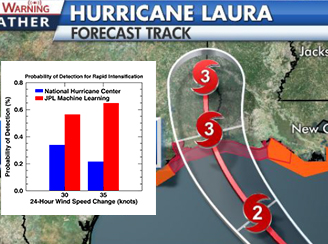 Improving Hurricane Forecasts with Machine Learning and NASA Satellite Data
Improving Hurricane Forecasts with Machine Learning and NASA Satellite Data
In the US, hurricane damage comes at an annual cost of $24 billion, over half the cost of all natural disasters. The National Hurricane Center (NHC) has an impressive record predicting where hurricanes might make landfall. But less successful are predictions of so-called "rapid-intensification" of the strength of landfalling hurricanes.
 Transport From the Asian Summer Monsoon Anticyclone Over the Western Pacific
Transport From the Asian Summer Monsoon Anticyclone Over the Western Pacific The Western Pacific is an accessible location that provides rich opportunities for investigating the impact of the Asian summer monsoon on global upper troposphere / lower stratosphere composition, e.g., through aircraft-based research campaigns.
 Aura MLS measures record-low levels of Arctic ozone
Aura MLS measures record-low levels of Arctic ozone Unusually prolonged cold stratospheric conditions in 2019/2020 have led to record-high chemical ozone loss and thus record-low ozone levels; only 2010/2011 came close. This behavior resembles that seen in the Antarctic, where an ozone "hole" recurs each winter.
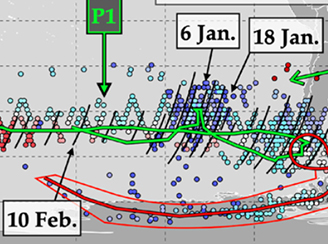 Plume from Australian fires influences stratospheric dynamics and composition
Plume from Australian fires influences stratospheric dynamics and composition An extraordinary complex of Australian fire-driven pyrocumulonimbus (pyroCb) storms at the end of 2019 produced an unprecedented stratospheric plume of fire emissions that circled the globe, rising from 15 to 31 km and persisting for more than two months.
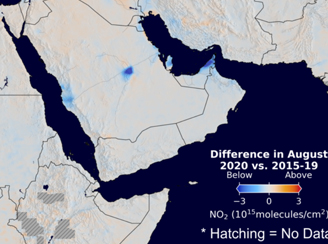 Impact of COVID-19 on Pilgrimage to Mecca as Assessed with Aura Ozone Monitoring Instrument (OMI) Nitrogen Dioxide
Impact of COVID-19 on Pilgrimage to Mecca as Assessed with Aura Ozone Monitoring Instrument (OMI) Nitrogen DioxideNitrogen Dioxide is an air pollutant and is primarily emitted from burning of fossil fuels (diesel, gasoline, coal) while driving cars and generating electricity.
 Near Ultraviolet Observations of the 2020 U.S. Wildfire Season
Near Ultraviolet Observations of the 2020 U.S. Wildfire SeasonUnprecedented amounts of pollution were produced by multiple fires over the USA west coast in September 2020. Continental scale smoke plumes from these wildfires were observed by the Ozone Monitoring Instrument (OMI) on the Aura satellite for about five weeks since the onset of the fires in early September.
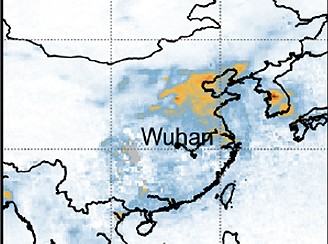 Abrupt decline in tropospheric nitrogen dioxide over China after the outbreak of COVID-19
Abrupt decline in tropospheric nitrogen dioxide over China after the outbreak of COVID-19 Aura's Ozone Monitoring Instrument (OMI) used in evaluating the reduction of nitrogen dioxide tropospheric vertical column densities before and after the Lunar New Year.
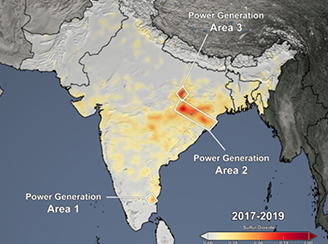 Reductions in Sulfur Dioxide & Nitrogen Dioxide Air Pollution over South Asia Associated with Efforts to Control the Spread of COVID-19
Reductions in Sulfur Dioxide & Nitrogen Dioxide Air Pollution over South Asia Associated with Efforts to Control the Spread of COVID-19As a consequence of the nationwide stay-at-home order, less fossil fuels are being consumed and, subsequently, less air pollution is being emitted in India and also in neighboring countries, including Pakistan, Nepal, Bangladesh, and Sri Lanka.
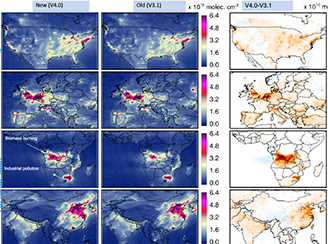 New Generation Nitrogen Dioxide Standard Product
New Generation Nitrogen Dioxide Standard Product The NASA standard nitrogen dioxide version 4.0 product for Aura's Ozone Monitoring Instrument (OMI) incorporates the most salient improvements and enhances the data quality.
 Solar Cycle Modulation of Nighttime Ozone Near the Mesopause
Solar Cycle Modulation of Nighttime Ozone Near the Mesopause What do long-term observations of ozone profiles from the Microwave Limb Sounder (MLS) aboard the Aura satellite tell us about the drivers of O3 variations near 90 km altitude (the secondary ozone maximum region), notably in relation to the 11-year solar cycle?
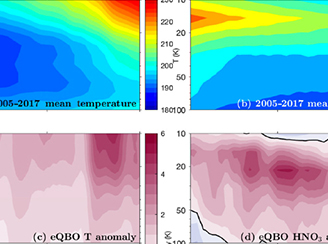 Energetic particle precipitation and the quasi-biennial oscillation modulate Antarctic springtime stratospheric column Nitrogen Dioxide
Energetic particle precipitation and the quasi-biennial oscillation modulate Antarctic springtime stratospheric column Nitrogen Dioxide Aura Microwave Limb Sounder (MLS) measurements have previously shown that the easterly phase of the QBO is associated with increases in nitrogen in the Antarctic stratosphere.
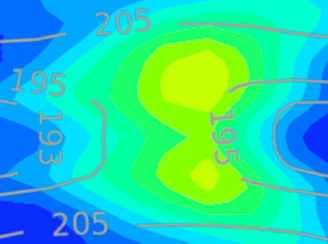 Impact of Convectively Lofted Ice on the Seasonal Cycle of Water Vapor in the Tropical Tropopause Layer
Impact of Convectively Lofted Ice on the Seasonal Cycle of Water Vapor in the Tropical Tropopause Layer Aura's MLS observes patterns of stratospheric humidity in the “Tropical Tropopause Layer” .
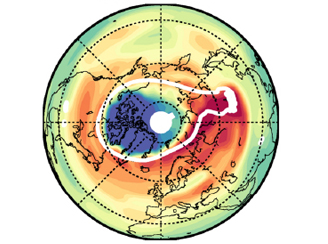 Aura MLS measures record-low levels of Arctic ozone
Aura MLS measures record-low levels of Arctic ozoneAura's MLS observations of Arctic vortex-average chlorine monoxide improve the understanding of stratospheric ozone trends and their uncertainties
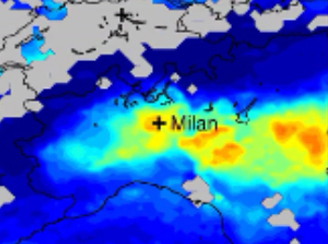 New Nitrogen Dioxide Web-based Monitoring System to Facilitate Scientific Research
New Nitrogen Dioxide Web-based Monitoring System to Facilitate Scientific Research To facilitate scientific research using Aura's OMI nitrogen dioxide data, the team at developed a web-based monitoring system that shows time series for over 200 world cities and animated maps for larger regions.
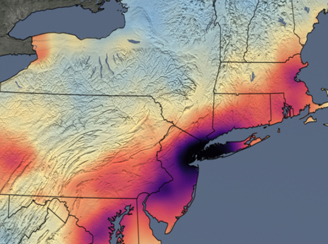 Reductions in Nitrogen Dioxide Air Pollution Presumably Associated with Reductions in Fossil Fuel Use
Reductions in Nitrogen Dioxide Air Pollution Presumably Associated with Reductions in Fossil Fuel UseThe Northeast US has seen significant reductions in air pollution over its major metropolitan areas as communities grapple with widespread lockdowns and shelter-in-place orders as a result of the spread of COVID-19.
 Reductions in Sulfur Dioxide & Nitrogen Dioxide Air Pollution over South Asia Associated with Efforts to Control the Spread of COVID-19
Reductions in Sulfur Dioxide & Nitrogen Dioxide Air Pollution over South Asia Associated with Efforts to Control the Spread of COVID-19 Aura's OMI data over South Asia show the means of the period in previous years, while the comparing to the means for 2020, showing a vast improvement after the nationwide stay-at-home order for India’s 1.3 billion citizens.
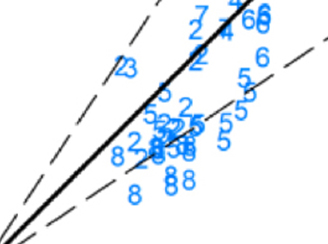 A Methodology To Constrain Carbon Dioxide Emissions From Coal-fired Power Plants Using Observations Of Co-emitted Nitrogen Dioxide
A Methodology To Constrain Carbon Dioxide Emissions From Coal-fired Power Plants Using Observations Of Co-emitted Nitrogen Dioxide Satellite-derived emission estimates are based on NO2 measurements from the Aura Ozone Monitoring Instrument (OMI).
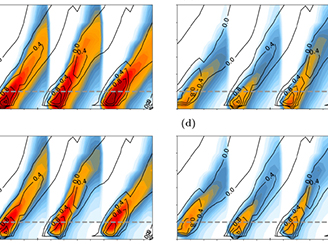 The Efficiency of transport into the stratosphere via the Asian and North American summer monsoon circulations
The Efficiency of transport into the stratosphere via the Asian and North American summer monsoon circulations This study confirms the important role of monsoon regions in moistening the lower stratosphere in boreal summer using data collected from Aura's Microwave Limb Sounder (MLS) .
 Ceramic industry at Morbi as a large source of sulfur dioxide pollution in India
Ceramic industry at Morbi as a large source of sulfur dioxide pollution in IndiaObservations from the Ozone Monitoring Instrument (OMI), onboard the NASA’s Earth Observing System (EOS) Aura satellite, reveal a large Sulfur dioxide pollution
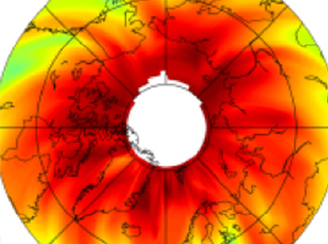 Vortex-wide detection of large polar stratospheric cloud particles in the Arctic winter stratosphere
Vortex-wide detection of large polar stratospheric cloud particles in the Arctic winter stratosphereDepletion of gas-phase nitric acid observed by Aura's Microwave Limb Sounder (MLS)